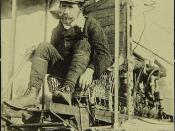Influencing Others in Business Environments
Throughout human civilization, the art of selling ideas or products has been a cornerstone of society. Some people have become masters at this art, yielding themselves and their companies large amounts of profit. Why is it that some people are better at this than others? This paper will take a look at the various aspects of nonverbal communication in selling (or influencing others to buy) and in job interviews by examining in detail the various aspects of proximics, haptics, physical attractiveness, and other nonverbal cues that influence people to say yes.
Artifacts and local environment
Several studies have presented evidence in support of the theory that 'dressing for success' affects one's ability to influence other people. One study found that people dressed in suits versus people dressed in casual or working-class clothes actually affects a subject's likelihood of answering a question correctly. In this study, a person dressed in a suit had a 77% percent chance of getting money returned to them, while those dressed casually or in working outfits had a 38% chance (Bickman, 1971).
This study suggests that a person's status affects how well they are received by the person they are trying to influence, and thus their likelihood of being able to influence them into buying an idea or product.
Seating arrangements can affect ones ability to influence others. Seating arrangements that are closer to one another have a greater effect and lead to a less hostile environment than when people are seated opposite of one another (Sommer, 1967). Sommer found that when a relationship is of a competitive nature (i.e. bargaining situations such as labor contract agreements) there is a preference for this style of seating because it 'reflects a desire to obtain information about one's competitor.' Another study suggested...



Great Essay!
I fond this essay to be very informative concerning nonverbal communication and ethics. Good job and thanks!
8 out of 8 people found this comment useful.